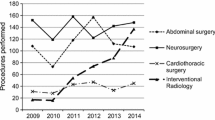Abstract
Background
Surgical outcomes are provider specific. This prospective audit describes the surgical activity of five general surgery residents on their trauma surgery rotation. It was hypothesized that the operating surgical trainee is an independent risk factor for adverse outcomes following major trauma.
Materials and methods
This is a prospective cohort study. All patients admitted, over a 6-month period (August 2014–January 2015), following trauma requiring a major operation performed by a surgical trainee at Groote Schuur Hospital’s trauma unit in South Africa were included. Multiple logistic regression models were built to compare risk-adjusted surgical outcomes between trainees. The primary outcome measure was major in-hospital complications.
Results
A total of 320 major operations involving 341 procedures were included. The mean age was 28.49 years (range 13–64), 97.2 % were male with a median ISS of 9 (IQR 1–41). Mechanism of injury was penetrating in 93.42 % of cases of which 51.86 % were gunshot injuries. Surgeon A consistently had the lowest risk-adjusted outcomes and was used as the reference for all outcomes in the regression models. Surgeon B, D, and E had statistically significant higher rates of major in-hospital complications than Surgeon A and C, after adjusting for multiple confounders. The final model used to calculate the risk estimates for the primary outcome had a ROC of 0.8649.
Conclusion
Risk-adjusted surgical outcomes vary by operating surgical trainee. The analysis thereof can add value to the objective assessment of a surgical trainee.
Similar content being viewed by others
References
Zargaran E, Schuurman N, Nicol AJ et al (2014) The electronic Trauma Health Record: design and usability of a novel tablet-based tool for trauma care and injury surveillance in low resource settings. J Am Coll Surg 218(1):41–50
Khuri SF, Daley J, Henderson W, National VA Surgical Quality Improvement Program et al (1998) The Department of Veterans Affairs’ NSQIP: the first national, validated, outcome-based, risk-adjusted, and peer-controlled program for the measurement and enhancement of the quality of surgical care. Ann Surg 228(4):491–507
Birkmeyer JD, Dimick JB, Birkmeyer NJ (2004) Measuring the quality of surgical care: structure, process, or outcomes? J Am Coll Surg 198(4):626–632
O’Connor GT, Plume SK, Olmstead EM, The Northern New England Cardiovascular Disease Study Group et al (1996) A regional intervention to improve the hospital mortality associated with coronary artery bypass graft surgery. JAMA 275(11):841–846
Gifford E, Kim DY, Nguyen A et al (2016) The effect of residents as teaching assistants on operative time in laparoscopic cholecystectomy. Am J Surg 211(1):288–293
Iannuzzi JC, Chandra A, Rickles AS et al (2013) Resident involvement is associated with worse outcomes after major lower extremity amputation. J Vasc Surg 58(3):827–831
Tsigonis AM, Landercasper J, Al-Hamadani M et al (2015) Are breast cancer outcomes compromised by general surgical resident participation in the operation? J Surg Educ 72(6):1109–1111
Meyerson SL, Teitelbaum EN, George BC et al (2014) Defining the autonomy gap: when expectations do not meet reality in the operating room. J Surg Educ 71(6):e64–e72
Patel M, Bhullar JS, Subhas G et al (2015) Present status of autonomy in surgical residency: a program director’s perspective. Am Surg 81(8):786–790
Sachs TE, Pawlik TM (2015) See one, do one, and teach none: resident experience as a teaching assistant. J Surg Res 195(1):44–51
Clavien PA, Barkun J, de Oliveira ML et al (2009) The Clavien–Dindo classification of surgical complications: five-year experience. Ann Surg 250(2):187–196
Haider AH, Hashmi G, Zafar SN et al (2014) Developing best practices to study trauma outcomes in large databases: an evidence-based approach to determine the best mortality risk adjustment model. J Trauma Acute Care Surg 76(4):1061–1069
Pearse RM, Rhodes A, Moreno R et al (2011) EuSOS: European Surgical Outcomes Study. Eur J Anaesthesiol 28(6):454–456
Meara JG, Leather AJ, Hagander L et al (2015) Global surgery 2030: evidence and solutions for achieving health, welfare, and economic development. Lancet 386(9993):569–624
Haynes AB, Regenbogen SE, Weiser TG et al (2011) Surgical outcome measurement for a global patient population: validation of the Surgical Apgar Score in 8 countries. Surgery 149(4):519–524
Bickler S, Ozgediz D, Gosselin R et al (2010) Key concepts for estimating the burden of surgical conditions and the unmet need for surgical care. World J Surg 34(3):374–380. doi:10.1007/s00268-009-0261-6
Haynes AB, Weiser TG, Berry WR et al (2009) A surgical safety checklist to reduce morbidity and mortality in a global population. N Engl J Med 360(5):491–499
Pearse RM, Moreno RP, Bauer P et al (2012) Mortality after surgery in Europe: a 7 day cohort study. Lancet 380(9847):1059–1065
Gonzalez AA, Dimick JB, Birkmeyer JD et al (2014) Understanding the volume-outcome effect in cardiovascular surgery: the role of failure to rescue. JAMA Surg 149(2):119–123
Reames BN, Ghaferi AA, Birkmeyer JD (2014) Hospital volume and operative mortality in the modern era. Ann Surg 260(2):244–251
McCulloch P, Nagendran M, Campbell WB et al (2013) Strategies to reduce variation in the use of surgery. Lancet 382(9898):1130–1139
Revels SL, Wong SL, Banerjee M et al (2014) Differences in perioperative care at low- and high-mortality hospitals with cancer surgery. Ann Surg Oncol 21(7):2129–2135
Donabedian A (2005) Evaluating the quality of medical care. Milbank Q 83(4):691–729
Author information
Authors and Affiliations
Corresponding author
Ethics declarations
Conflict of interest
No conflicts of interests.
Rights and permissions
About this article
Cite this article
Spence, R.T., Zargaran, E., Hameed, M. et al. An Objective Assessment of the Surgical Trainee in an Urban Trauma Unit in South Africa: A Pilot Study. World J Surg 40, 1815–1822 (2016). https://doi.org/10.1007/s00268-016-3503-4
Published:
Issue Date:
DOI: https://doi.org/10.1007/s00268-016-3503-4




